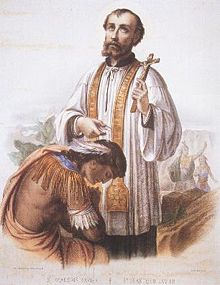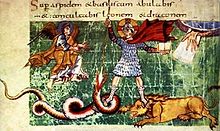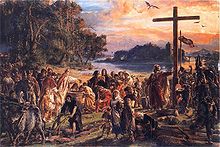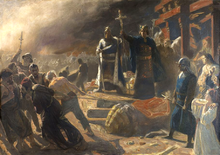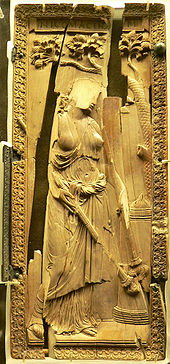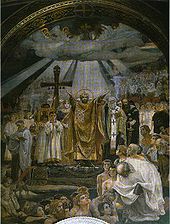- Christianization
-
The historical phenomenon of Christianization (or Christianisation) is the conversion of individuals to Christianity or the conversion of entire peoples at once. It also includes the practice of converting native pagan practices and culture, pagan religious imagery, pagan sites and the pagan calendar to Christian uses, due to the Christian efforts at proselytism (evangelism) based on the tradition of the Great Commission.
The process of Christianization has at times been relatively peaceful and at times has been a very violent process, ranging from political conversions to adopt Christianity to military campaigns to force conversion onto native populaces often resulting in massacres and murder.
Various strategies and techniques employed in Christianization campaigns from Late Antiquity through the Middle Ages: Ancient holy sites were destroyed or converted to Christian churches, indigenous pagan gods were demonized, and traditional religious practices were condemned as witchcraft and even criminalized — sometimes upon penalty of death.[1]
Reformatting native religious and cultural activities and beliefs into a Christianized form was officially sanctioned; preserved in the Venerable Bede's Historia ecclesiastica gentis Anglorum is a letter from Pope Gregory I to Mellitus, arguing that conversions were easier if people were allowed to retain the outward forms of their traditions, while claiming that the traditions were in honour of the Christian God, "to the end that, whilst some gratifications are outwardly permitted them, they may the more easily consent to the inward consolations of the grace of God". In essence, it was intended that the traditions and practices still existed, but that the reasoning behind them was altered. The existence of syncretism in Christian tradition has long been recognized by scholars, and in recent times many of the instances of syncretism have also been acknowledged by the Roman Catholic church.[citation needed]
Humanistic studies of Antiquity and the Reformation combined in the sixteenth century to produce works of scholarship marked by an agenda that was occupied with identifying Roman Catholic practices with paganism, and identifying the emerging Protestant churches with a purgative "re-Christianization" of society. The Lutheran scholar Philip Melanchthon produced his Apologia Confessionis Augustanae (1530) detailing the rites derived from pagan practices. Heinrich Bullinger, De origine erroris libris duo (1539) detailed the pagan "origins of (Catholic) errors".
Isaac Casaubon, De rebus sacris et ecclesiasticus exercitationes (1614) makes a third familiar example, where sound scholarship was somewhat compromised by sectarian pleading. Thus such pagan precedents for Christian practice have tended to be downplayed or even sometimes dismissed by Christian apologists as a form of Protestant Apologetics.
The 20th century saw more purely historical inquiries, free of sectarian bias; an early historicist classic in this field of study was Jean Seznec's The Survival of the Pagan Gods: the mythological tradition and its place in Renaissance humanism and the arts. (1972).
Contents
Early Christianity (pre-Nicaean)
The Council of Jerusalem ( around 50 AD ), according to Acts 15, determined that circumcision was not required of Gentile converts, only avoidance of "pollution of idols, fornication, things strangled, and blood" (KJV, Acts 15:20), establishing nascent Christianity as an attractive alternative to Judaism for prospective Proselytes. The Twelve Apostles and the Apostolic Fathers initiated the process of integration of the originally Jewish sect (outlawed as religio illicita since the 80s) into Hellenistic religion (Christianity and Neoplatonism), a process culminating only at the end of Classical Antiquity, with Pseudo-Dionysius the Areopagite.
The Armenian and Ethiopian churches are the only instances of imposition of Christianity by sovereign rulers predating the council of Nicaea. The initial conversion of the Roman Empire occurred mostly in urban areas of Europe, where the first converts occurred through the conversion of most of the Jewish population. Later conversions happened among the Grecian-Roman-Celtic populations over centuries, again mostly among its urban population and only spread to rural populations in much later centuries. The term "pagan" is from Latin, it means "villager, rustic, civilian" and is derived from this historical transition. The root of that word is present in today's word "paisan" or "paisano". Consequently, while the initial converts were found among the Jewish populations, the development of the Orthodox Church as an aspect of State society occurred through the co-option of State Religion into the ethos of Christianity and only then was conversion of the large rural population accomplished.
Late antiquity (4th-6th centuries)
Main article: Decline of Hellenistic paganismWhen Yale historian Ramsay MacMullen treated the Christianization of the Roman Empire, he divided his book in two sections, before and after the year 312, which marked the momentous conversion of Constantine. Constantine ended the persecution of Christianity (and other religions) with the Edict of Milan, so that the Imperial pagan religion of Ancient Rome was no longer the only acceptable religion by the state. Whether or not Constantine himself was a proponent of what was to follow is contested. Under Constantine's successors, Christianization of Roman society proceeded by fits and starts, as John Curran recently documented in detail.[2]
Constantine's sons, for example, banned pagan State religious sacrifices in 341, but did not close the temples. Although all State temples in all cities were ordered shut in 356, there is evidence that traditional sacrifices continued. Under Julian, the temples were reopened and State religious sacrifices legalized once more. When Gratian declined the position and title of Pontifex Maximus, his act effectively brought an end to the state religion due to the positions authority and ties within the Imperial administration. Again however, this process ended State official practices but not the private religious practices. Consequently, the temples remained open until Theodosius I[3] made the public expression of the ancient cults illegal, bringing an era of religious toleration decisively to an end.
After Rome was declared a Christian Empire by Theodosius in 380 with the edict of Thessalonica, laws were passed against pagan practices over the course of the following years. Many of the ancient pagan temples were subsequently defiled, sacked, and destroyed, or converted into Christian sites. As such, the Christianization attributed to Constantine eventually became a more coercive process under Theodosius.
The early Christianization of the various Germanic peoples was achieved by various means, and was partly facilitated by the prestige of the Christian Roman Empire amongst European pagans. The early rise of Germanic Christianity was, thus, mainly due to voluntary conversion on a small scale.
In the 4th century some Eastern Germanic tribes, notably the Goths, an East Germanic tribe, adopted Arianism. From the 6th century, Germanic tribes were converted (and re-converted) by missionaries of the Roman Catholic Church, firstly among the Franks, after Clovis I's conversion to Catholicism in 496. The Lombards adopted Catholicism as they entered Italy, also during the 6th century.
Unlike the history of Christianity in the Roman Empire, conversion of the West and East Germanic tribes took place "top to bottom", in the sense that missionaries aimed at converting Germanic nobility first, which would then impose their new faith on the general population.
The Franks were converted in the 5th century, after Clovis I's conversion to Catholicism. In 498 (497 or 499 are also possible) he let himself be baptised in Reims.[4] With this act, the Frankish Kingdom became Christian, although it would take until the 7th century for the population to abandon some of their pagan customs.[5] This was typical of the Christianization of Europe. Christian and pagan practices would effectively exist in parallel.
Christianization of Europe (7th-15th centuries)
Anglo-Saxon England
During the reign of Ethelbert of Kent, Pope Gregory I decided to regain the island for Christianity. Between the sixth and the tenth century, the mission of the Catholic Church and the Hiberno-Scottish mission Christianized England, working largely independently.
Frankish Empire
The Germanic peoples underwent gradual Christianization in the course of the Early Middle Ages, resulting in a unique form of Christianity known as Germanic Christianity in some cases. The Eastern and Western tribes were the first to convert through various means. However, it would not be until the 12th century that the North Germanic Tribes had Christianized.
In the polytheistic Germanic tradition it was possible to worship Jesus next to the native gods like Woden and Thor. Before a battle, a pagan military leader might pray to Jesus for victory, instead of Odin, if he expected more help from the Christian God. According to legend, Clovis had done that before a battle against one of the kings of the Alamanni, and had thus attributed his victory to Jesus.[6] The Christianization of the Franks laid the foundation for the further Christianization of the Germanic peoples.
The next impulse came from the edge of Europe. Although Ireland had never been part of the Roman Empire, Christianity had come there and developed, largely independently into Celtic Christianity. The Irish monks had developed a concept of peregrinatio.[7] This essentially meant, that a monk would leave the monastery and his Christian country to proselytize among the heathens, as self-chosen punishment for his sins. From 590 onwards Irish missionaries were active in Gaul, Scotland, Wales and England.
During the Saxon Wars, Charlemagne, King of the Franks, forcibly Christianized the Saxons by way of warfare and law upon conquest. Examples include the Massacre of Verden in 782, during which Charlemagne reportedly had 4,500 captive Saxons massacred upon rebelling against conversion, and the Capitulatio de partibus Saxoniae, a law imposed on conquered Saxons in 785 which prescribes death to those that refuse to convert to Christianity.[8]
Great Moravia
What modern historians designate as Great Moravia was a Slavic state that existed in Central Europe from around 830 to the early 10th century. The territory of Great Moravia was originally evangelized by missionaries coming from the Frankish Empire or Byzantine enclaves in Italy and Dalmatia since the early 8th century and sporadically earlier.[9][10] The first Christian church of the Western and Eastern Slavs known to the written sources was built in 828 by Pribina, the ruler and Prince of the Principality of Nitra, although probably still a pagan himself, in his possession called Nitrava (today Nitra, Slovakia).[11][12] The first Moravian ruler known by name, Mojmír I, was baptized in 831 by Reginhar, bishop of Passau.[13] Despite the formal endorsement by the elites, the Great Moravian Christianity was described as containing many pagan elements as late as in 852.[14]
The Church organization in Great Moravia was supervised by the Bavarian clergy until the arrival of the Byzantine missionaries Saints Cyril and Methodius in 863, upon Prince Rastislav's request. Cyril developed the first Slavic alphabet and translated the Gospel into the Old Church Slavonic language. Foundation of the first Slavic bishopric (870), archbishopric (880), and monastery was the politically relevant outcome of the Byzantine mission. In 880, Pope John VIII issued the bull Industriae Tuae, by which he set up an independent ecclesiastical province in Great Moravia with Archbishop Methodius as its head. He also named the German cleric Wiching the Bishop of Nitra, and Old Church Slavonic was recognized as the fourth liturgical language, along with Latin, Greek and Hebrew.
Bulgaria
After its establishment under Khan Asparukh in 681, Bulgaria retained the traditional Bulgar religion Tengriism and the pagan beliefs of the local Slavic population. In the mid 9th century Boris I decided to establish Christianity as a state religion in Bulgaria. In 864 he was baptised in the capital Pliska by Byzantine priests and after prolonged negotiations with both Rome and Constantinople he managed to create an autocephalous Bulgarian Orthodox Church and used the newly created Cyrillic alphabet to make Bulgarian language the language of the Church.
Christianity was challenged during the rule of his first-born son Vladimir-Rasate (889-893) who decided to return to the old Bulgarian religion. Boris I who had previously retired to a monastery led a rebellion against his son and defeated him. At the counsel of Preslav in 893 his third son Simeon I, born after the Christianization was installed on the throne and the capital was moved from Pliska to Preslav as a symbol of the abolition of the old religion. Simeon I led series of wars against the Byzantines to gain official recognition of his Imperial title and the full independence of the Bulgarian Church. As a result of his victories in 927 the Byzantines finally recognized the Bulgarian Patriarchate.
Poland
Main article: Christianization of PolandThe "Baptism of Poland" (Polish: Chrzest Polski) in 966 refers to the baptism of Mieszko I, the first ruler of a united Polish state. His baptism was followed by the building of churches and the establishment of an ecclesiastical hierarchy. Mieszko saw baptism as a way of strengthening his hold on power, with the active support he could expect from the bishops, as well as a unifying force for the Polish people. Mieszko's action proved highly successful; by the 13th century, Roman Catholicism had become the dominant religion in Poland.
Hungary
 Image of the King Saint Stephen I of Hungary, from the medieval codex Chronicon Pictum from the XIV century.
Image of the King Saint Stephen I of Hungary, from the medieval codex Chronicon Pictum from the XIV century.
In the Middle Ages, the Kingdom of Hungary (which was larger than modern day Hungary) was Christianized initially by Greek monks sent from Constantinople to convert the pagan Hungarians. In 950 the tribal chief Gyula II of Transylvania visited Constantinople and was baptized. Gyula also had his officers and family baptized under the orthodox (Roman Catholic) confession. The conversion of the Hunagrian people was not completed until the reign of Gyula's grandson, King Stephen I of Hungary. Stephen was the son of Grand Prince Géza of Hungary and Sarolt, the daughter of Gyula II. His authority as leader of the Hungarian tribal federation was recognized with a crown from Pope Sylvester II. King Stephen converted the nomadic barbarian tribes of the Hungarians and induced them to sedentary culture. The conversion of Hungary is said to have been completed by the time of Stephen's death in 1038.
Soon the Hungarian Kingdom counted with two archbishops and 8 bishops, a defined state structure with province governors that answered to the King. In the other hand, Saint Stephen oppened the frontiers of his Kingdom in 1016 to the pilgrims that travelled by land to the Holy Land, and soon this route became extremely popular, being used later in the Crusades. Saint Stephen was the first monarch that was elevated to the sanctity for his Christian characteristics and not because suffered a martyr death.[15]
Kievan Rus'
Between the 8th and the 13th century the area of what now is Belarus, Russia and Ukraine was settled by the Kievan Rus'. An attempt to Christianize them had already been made in the 9th century, with the Christianization of the Rus' Khaganate. The efforts were finally successful in the 10th century, when about 980 Vladimir the Great was baptized at Chersonesos.
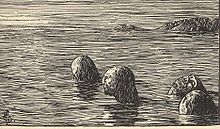 According to Heimskringla, During the Christianization of Norway, King Olaf Trygvasson had male völvas (shamans) tied up and left on a skerry at ebb (woodcut by Halfdan Egedius (1877-1899).
According to Heimskringla, During the Christianization of Norway, King Olaf Trygvasson had male völvas (shamans) tied up and left on a skerry at ebb (woodcut by Halfdan Egedius (1877-1899).
For the purposes of this article the Christianization of Scandinavia refers to the process of conversion to Christianity of the Scandinavian people, starting in the 8th century with the arrival of missionaries in Denmark and it was at least nominally complete by the 12th century, although the Samis remained unconverted until the 18th century.
In fact, although the Scandinavians became nominally Christian, it would take considerably longer for actual Christian beliefs to establish themselves among the people.[16] The old indigenous traditions that had provided security and structure since time immemorial were challenged by ideas that were unfamiliar, such as original sin, the Immaculate Conception, the Trinity and so forth.[16] Archaeological excavations of burial sites on the island of Lovön near modern-day Stockholm have shown that the actual Christianization of the people was very slow and took at least 150–200 years,[17] and this was a very central location in the Swedish kingdom. 13th century runic inscriptions from the bustling merchant town of Bergen in Norway show little Christian influence, and one of them appeals to a Valkyrie.[18] At this time, enough knowledge of Norse mythology remained to be preserved in sources such as the Eddas in Iceland.
Baltic
Danish Bishop Absalon destroys the idol of Slavic god Svantevit at Arkona in a painting by Laurits Tuxen
The Northern Crusades[19] or Baltic Crusades[20] were crusades undertaken by the Catholic kings of Denmark and Sweden, the German Livonian and Teutonic military orders, and their allies against the pagan peoples of Northern Europe around the southern and eastern shores of the Baltic Sea. Swedish and German campaigns against Russian Eastern Orthodox Christians are also sometimes considered part of the Northern Crusades.[19][21] Some of these wars were called crusades during the Middle Ages, but others, including most of the Swedish ones, were first dubbed crusades by 19th century romantic nationalist historians.
Lithuania and Samogitia were ultimately Christianized from 1386 until 1417 by the initiative of the Grand Duke of Lithuania Jogaila and his cousin Vytautas.
Reconquista
Between 711–718 the Iberian peninsula had been conquered by Muslims in the Umayyad conquest of Hispania; Between 722 (see: Battle of Covadonga) and 1492 (see: the Conquest of Granada) the Christian Kingdoms that later would become Spain and Portugal reconquered it from the Moorish states of Al-Ándalus. The notorious Spanish Inquisition and Portuguese Inquisition were not installed until 1478 and 1536 when the Reconquista was already (mostly) completed.
Colonial era (16th−19th centuries)
The expansion of the Catholic Portuguese Empire and Spanish Empire with a significant role played by Catholic missionaries led to the Christianization of the indigenous populations of the Americas such as the Aztecs and Incas. Large number of churches were built.[22][23]
Later waves of colonial expansion such as the Scramble for Africa or the struggle for India, by the Netherlands, Britain, France, Germany and Russia led to Christianization of other native populations across the globe such as the Indigenous peoples of the Americas, Filipinos, Indians and Africans led to the expansion of Christianity eclipsing that of the Roman period and making it a truly global religion.[24]
20th century
Sacred sites
Many Christian churches were built upon sites already consecrated as pagan temples or mithraea, the church of Santa Maria sopra Minerva (literally Saint Mary above Minerva) in Rome being simply the most obvious example, though a period of about 350 years of abandonment intervened between temple and church in this case. Sulpicius Severus, in his Vita of Martin of Tours, a dedicated destroyer of temples and sacred trees, remarks "wherever he destroyed heathen temples, there he used immediately to build either churches or monasteries",[25] and when Benedict took possession of the site at Monte Cassino, he began by smashing the sculpture of Apollo and the altar that crowned the height.
The British Isles and other areas of northern Europe that were formerly druidic are still densely punctuated by holy wells and holy springs that are now attributed to some saint, often a highly local saint unknown elsewhere; in earlier times many of these were seen as guarded by supernatural forces such as the melusina, and many such pre-Christian holy wells appear to survive as baptistries.[26] Not all pre-Christian holy places were respected enough for them to survive, however, as most ancient European sacred groves, such as the great Irminsul (whose location is now lost, but was possibly located at Externsteine), were destroyed by Christianizing forces.
During the Reconquista and the Crusades, the cross served the symbolic function of possession that a flag would occupy today. At the siege of Lisbon in 1147, when a mixed group of Christians took the city, "What great joy and what a great abundance there was of pious tears when, to the praise and honor of God and of the most Holy Virgin Mary the saving cross was placed atop the highest tower to be seen by all as a symbol of the city's subjection."[27]
Myths and imagery
Main article: Christianised Myths and ImageryThe historicity of several saints has often been treated sceptically by most academics, either because there is a paucity of historical evidence for them, or due to striking resemblances that they have to pre-Christian deities. In 1969 the Roman Catholic Church officially decanonised some Christian Saints, demoted others, and pronounced the historicity of others to be dubious. Though highly popular in the Middle Ages, many of these such saints have since been largely forgotten, and their names may now seem quite unfamiliar. The most prominent amongst these is Saint Eustace, who was extremely popular in earlier times, but scholars now see as a chimera composed from details of several other Saints. Many of these figures of dubious historicity appear to be based on figures from pre-Christian myth and legend, Saint Sarah, for example, also known as Sarah-la-Kali, is thought by scholars to be a Christianization of Kali, a Hindu deity.
Symbols and symbolism
Although the cross is currently the most common symbol of Christianity, and has been for many centuries, it only came to prominence during the fourth century, and was not particularly associated with Christianity before that time. According to Christian tradition, the cross is a reference to the crucifixion of Jesus, and the crucifix is a more obvious, and some would say gruesome, version of such a reference. However, due to the highly ambiguous nature of the Greek terms used in the bible for his crucifixion, it may be the case that the correct translation actually points to Jesus having just been tied to a single stake of wood, rather than the cross shaped device in traditional depictions; though Christian translations into English often render these terms as nailed to a cross, they could equally mean nailed to a tree and nailed to a wooden pole, which was another common method of crucifixion in the Roman empire - the hands being tied above the head. Though some people believe John 20:25 in the Bible disproves this theory. Considering the terms in this passage use the plural form of "nail". So if a stake were used, instead of a cross, then Jesus' hands would have been placed above His head with a nail driven through His wrists. Since the wrists would most likely overlap, only one nail is needed through both wrists. But John 20:25 says "nails" so the case is that it was more than likely an actual cross with two pieces of wood and the hands apart, just as tradition in Church history states.
The predecessor of the cross as the main Christian symbol was the labarum, a symbol formed by overlaying the first two letters of the Greek word for Christ in the Greek alphabet. Constantine I is widely considered to have introduced the symbol into Christianity, but the symbol itself predates this, and was also used by the major religion of Sol Invictus, due to its prior use as a major symbol representing good fortune[citation needed]. Prior to Christianity, the symbol had become considered to represent auspiciousness since it was earlier the symbol of Chronos[citation needed], the Greek deity of time itself, whose name it forms the monogram of, in much the same way as it monograms an epithet given by Christians to Jesus.
Although Christian tradition argues that Constantine chose the labarum because he had a vision that led him to convert to Christianity, Constantine's conversion is disputed by many historians since he continued using clearly Sol Invictus-related symbolism and wording on his currency for much of the remainder of his life, remained the Pontifex Maximus of Mithraism/Ancient Roman religion for his entire life, and was only baptized on his deathbed (although this was common at the time; many Christians believed that if one sinned after baptism one's salvation was lost)[citation needed], and even that is disputed since the only witnesses were the same people that claimed that Constantine had been Christian for much longer. Most secular historians see Constantine's motive for choosing the labarum as political rather than supernatural or religious, with him deliberately making his banner one which could be interpreted as supporting either of the two major religions of the Roman Empire at the time; Constantine saw unity and conformity as the way to achieve political stability, and spent a great deal of time attempting to reduce division (for example by holding the First Council of Nicaea to settle the question of Arianism). Although many Christian groups treat the symbol as having always been exclusively Christian, certain Protestant groups support the conclusions of secular scholars, and consequently regard the symbol as non-Christian, disowning it.
Prior to the labarum, the main Christian symbol, and the earliest, was a fish-like symbol now known as Ichthys (the Greek word for fish); the Greek word ιχθυς is an acronym for the phrase transliterated as "Iesou Christos Theou Yios Sotiras", that is, "Jesus Christ, God's Son, the Savior". There are several other connections with Christian tradition relating to this choice of symbol: that it was a reference to the feeding of the multitude; that it referred to some of the apostles having previously been fishermen; or that the word Christ was pronounced by Jews in a similar way to the Hebrew word for fish (though Nuna is the normal Aramaic word for fish, making this seem unlikely).
See also
- Christian debate on persecution and toleration
- European colonization of the Americas
- Goa Inquisition
- Missions
- Missionaries in India
- Crusades
- Conquistador
- Taiping Rebellion
Notes
- ^ Sanmark, Alexandra (2003), PDF "Power and Conversion: A Comparative Study of Christianization in Scandinavia", Occasional Papers in Archaeology 34, http://uhi.academia.edu/documents/0065/1378/Sanmark2004_OPIA34.pdfPDF
- ^ Curran 2000.
- ^ Living Letters of the Law: Ideas of the Jew in Medieval Christianity (The S. Mark Taper Foundation Imprint in Jewish Studies) by Jeremy Cohen,1999,page 23,"... Augustine formally embraced Christianity soon after Theodosius the Great declared it the official religion of the empire. ..."
- ^ Padberg, Lutz v. (1998), p.45-48, p.53
- ^ Grave goods, which of course are not a Christian practice, have been found until that time; see: Padberg, Lutz v. (1998), p.59
- ^ Padberg, Lutz v. (1998), p.48
- ^ Padberg, Lutz v. (1998), p.67
- ^ For the Massacre of Verden, see Barbero, Alessandro (2004). Charlemagne: Father of a Continent, page 46. University of California Press. For the Capitulatio de partibus Saxoniae, see Riché, Pierre (1993). The Carolingians. University of Pennsylvania Press. ISBN 9780812213423.
- ^ Poulik, Josef (1978). "The Origins of Christianity in Slavonic Countries North of the Middle Danube Basin". World Archaeology 10 (2): 158–171. doi:10.1080/00438243.1978.9979728.
- ^ Stanislav, Ján (1934). Životy slovanských apoštolov Cyrila a Metoda. Panonsko-moravské legendy.. Bratislava, Praha: Vydané spoločne nakladateľstvom Slovenskej ligy a L. Mazáča. http://www.proglas.sk/Metod.htm. Retrieved 2009-10-09.
- ^ Bartoňková Dagmar, et al., ed (1969). "Libellus de conversione Bagoariorum et Carantanorum (i.e. Conversio)". Magnae Moraviae fontes historici III. Praha: Statni pedagogicke nakl..
- ^ Conversio Bagoariorum et Carantanorum: "Adalramus archepiscopus ultra Danubium in sua proprietate loco vocato Nitrava consecravit ecclesiam." ("Archbishop Adalram consecrated a church for him over the Danube on his possession called Nitra.")
- ^ Sommer, Petr; Trestik, Dusan; Zemlicka, Josef (2007), "Bohemia and Moravia", in Berend, Nora, Christianization and the rise of Christian monarchy : Scandinavia, Central Europe and Rus' c. 900-1200, Cambridge, UK ; New York: Cambridge University Press, pp. 214–262
- ^ Barford, P. M. (2001). The early Slavs : culture and society in early medieval Eastern Europe. Ithaca, NY: Cornell University Press.
- ^ Sisa, Stephen. (1995). The Spirit of Hungary : A Panorama of Hungarian History and Culture. Vista Court Books. Millington, NJ: United States
- ^ a b Schön 2004, 170
- ^ Schön 2004, 172
- ^ Schön 2004, 173
- ^ a b Christiansen, Erik (1997). The Northern Crusades. London: Penguin Books. pp. 287. ISBN 0-14-026653-4.
- ^ Hunyadi, Zsolt; József Laszlovszky (2001). The Crusades and the Military Orders: Expanding the Frontiers of Medieval Latin Christianity. Budapest: Central European University Press. pp. 606. ISBN 9639241423.
- ^ An Historical Overview of the Crusade to Livonia by William Urban
- ^ Kenneth Scott Latourette, A History of the Expansion of Christianity Volume 3 Three Centuries Of Advance A.D. 1500-A.D. 1800 (1939)
- ^ Guy Stresser-Pean, The Sun God and the Savior: The Christianization of the Nahua and Totonac in the Sierra Norte De Puebla, Mexico (2009)
- ^ Stuart B. Schwartz, All Can Be Saved: Religious Tolerance and Salvation in the Iberian Atlantic World (2009)
- ^ Vita, ch xiii
- ^ paper read in 1999 by Samuel J. Barnish
- ^ De expugnatione Lyxbonensi
References
- Curran, John 2000. Pagan City and Christian Capital. (Oxford) ISBN 0-19-815278-7. Reviewed by Fred S. Kleiner in Bryn Mawr Classical Review 20
- Kaplan, Steven 1984 Monastic Holy Man and the Christianization of Early Solomonic Ethiopia (in series Studien zur Kulturkunde) ISBN 3-515-03934-1
- Kerenyi, Karl, Dionysus: Archetypal Image of Indestructible Life 1976.
- MacMullen, Ramsay, Christianizing the Roman Empire, AD 100 – 400 Yale University Press (paperback, 1986 ISBN 0-300-03642-6 )
- Fletcher, Richard, The Conversion of Europe. From Paganism to Christianity 371-1386 AD. London 1997.
- Padberg, Lutz v., (1998): Die Christianisierung Europas im Mittelalter, Stuttgart, Reclam (German)
- Trombley, Frank R., 1995. Hellenic Religion and Christianization c. 370-529 (in series Religions in the Graeco-Roman World) (Brill) ISBN 90-04-09691-4
- Vesteinsson, Orri, 2000. The Christianization of Iceland: Priests, Power, and Social Change 1000-1300 (Oxford:Oxford University Press) ISBN 0-19-820799-9
External links
- Jorge Quiroga and Monica R. Lovelle, "Ciudades atlánticas en transición: La “ciudad” tardo-antigua y alto-medieval en el noroeste de la Península Ibérica (s.V-XI)" from Archeologia Medievale vol xxvii (1999), pp 257–268 Christianizing Late Antique Roman sites from the 6th century onwards.
- Unilineal Descent Groups and Deep Christianization: A Cross-Cultural Comparison
Cultural assimilation Africanization · Albanization · Americanization · Anglicization · Arabization · Araucanization · Batavianization · Bulgarization · Castilianization · Christianization · Croatization · Czechization · Desinicization · Estonianization · Europeanization · Fennicization · Francization · Gaelicization · Germanization · Globalization · Hellenization · Hispanicization · Islamization · Italianization · Japanization · Judaization · Kurdification · Lithuanization · Magyarization · Pashtunization · Persianization · Polonization · Romanianization · Romanization (cultural) · Russification · Sanskritization · Serbianization · Sinhalization · Sinicization · Slavicization · Slovakization · Sovietization · Swahilization · Syrianization · Taiwanization · Thaification · Turkification · Turkmenization · Ukrainization · Uzbekization · Westernization · Indo-AryanizationCategories:- History of Christianity
- Christian interfaith and secular relations
- Conversion to Christianity
- Cultural assimilation
- Christian terms
Wikimedia Foundation. 2010.

